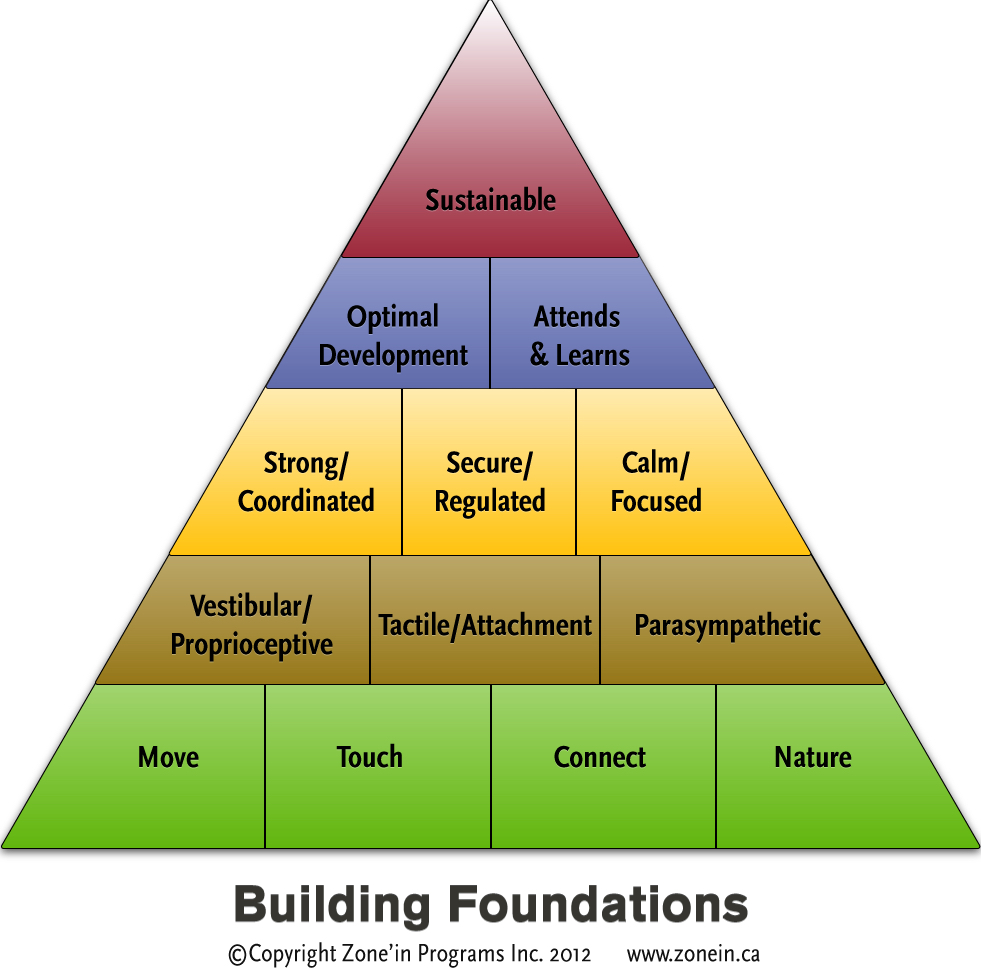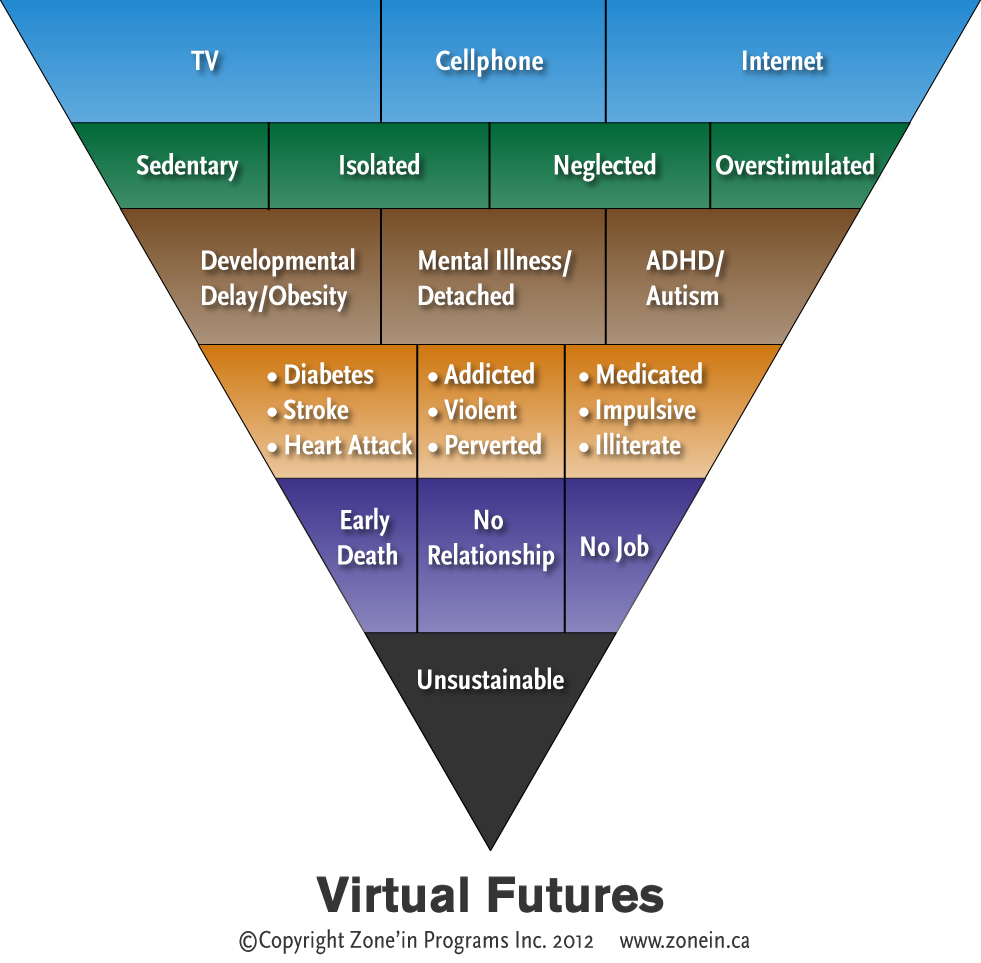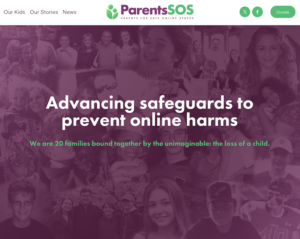Brain Development Explained
Overuse of entertainment-based screen technologies including social media, video games and pornography, has both direct and indirect, long reaching impact on children and youth. Parents, teachers and clinicians are just beginning to detect the direct effects of screens on kids including mental illness, physical delays, social disorders, behavior problems including aggression, and impaired brain development to name a few. This article written by a pediatric, occupational therapist intends to profile normative brain and body development in children and then explore the indirect and far-reaching implications of pervasive screen over use by children. Comprehending the damage screens are causing to children requires an understanding of basic brain and body development. When mammals are born, they are almost mature and usually leave the parents within a year. When a child is born, they require a full 18-20 years of parenting to reach maturity. Human brain development occurs in relationship to the stimuli in the environment. Brain development is best illustrated when compared to a road map where there are large and small roads, or neurons, that traverse the whole landscape. At birth (nature), all the large roads are in place to access all areas of the brain, and the small roads form relevant to the environment (nurture). Over the child’s lifetime there are two processes that occur in the brain: proliferation and pruning which serve to shape and change the brain according to the type and amount of stimulation found in the environment. This modelling process achieves brain efficiency and occurs rapidly during 0-2 years of age and then slows down as the child reaches maturity. Proliferation is described as smaller roads built for the purpose of connecting the big roads. Pruning is described as elimination of roads that aren’t being used. By death, 2/3 of neurons that are not being used will be pruned. Brain pruning and proliferation in relation to a child’s environment, pretty much determines the type of child they become. “You are what you do” or “you become what you watch” best describes how the wiring of the brain creates the foundation for the developing child.

Body Development Explained
Growing a child is like building a house – it’s all about the foundation. There are 4 critical factors for optimizing a child’s brain and body development and learning: movement, touch, human connection and nature. Movement activates 3 systems (vestibular, proprioceptive, cardiovascular) to achieve optimal fitness, as well as a strong core, motor coordination and spatial awareness. These foundational components are required to achieve academic skills including printing, reading, math and physical literacy. Touch activates the parasympathetic nervous system to lower adrenalin which reduces anxiety and agitation and helps a child feel relaxed and regulated. Human connection activates the attachment system releasing oxytocin which helps a child to feel loved and secure. An enriched environment with lots of movement, touch, human connection and nature and limited screen use, will result in diverse wiring (proliferation) to all areas of the brain with minimal pruning as the child is using ALL of their brain and body. A deprived environment lacking in movement, touch, human connection and nature, with early exposure and long duration of screen use, will result in focused wiring only to areas of the brain being used, and pruning to areas that are not being used.
Media Content and Duration are Key
Much of digital media content simply entertains the child and is termed “mindless” in that the child doesn’t have to ‘think’ to process content. Mindless digital media content includes cartoons, video games, social media, sitcoms, pornography, movies and a significant amount of content that is considered to be ‘educational’. Mindless content results in pruning of neurons to the front of the child’s brain resulting in atrophy or death of areas required for memory, attention, concentration, impulse control, rational judgement and critical thinking. “Mindful” digital media content makes the brain think and supports diversity of brain maturation and includes nature shows, sports, DIY videos, strategy video games etc. Education technology (edtech) unfortunately lacks credible research evidence to support it’s use as most of the studies (if there are any) are performed by the education technology industry itself. Mindful content (within expert duration guidelines) results in a brain that is fully operational and can pay attention and learn. Pediatricians have set guidelines for screen use to be ‘no screens’ for 0-2 years, no more than 1 hour per day for 3-5 years and no more than 2 hours per day 6-12 years. Regarding content, pediatricians recommend no violent media content for children under the age of 6 years, and very limited content to age 12 year citing detrimental impact of violence and rapid brain development. Pediatricians also recommend at least 2 hours per day of active play and 10 hours per day of sleep. Currently only 10% of children are meeting those guidelines. Consequently, we are seeing a host of child disorders that have reached epidemic proportions. The ways in which we are raising and educating children with screens are simply no longer sustainable.
Detrimental Impact of Screen Overuse on Children
Prolific research of over 450 studies topically organized and collated by author shows screen overuse is causing significant harm to our children. Until research adequately proves screens are safe, all use of mindless entertainment content should be banned for children and youth under the age of 18 years. This initiative would promote engagement in the 4 critical factors for optimizing development and learning, and result in happy, healthy and smart children. Homes, schools and communities should team together to create challenging and interesting play spaces for all age groups and include equipment for adults to entice them to bring their kids there. Overuse of entertainment-based screen technologies including TV, cell phone and internet content, create a child who is sedentary, isolated, neglected, overstimulated and exposed to harmful content and wireless radiation. Why is no one acting to protect children? Follow the dollar. Apple, Amazon, Google and Facebook spent $250 million last year to kill anticompetitive business practices. The technology industry, as well as everyone who has been bought by the Big Tech (government, schools, politicians, media etc.) needs to know the following information and then act in the best interest of children, not profit.
Virtual Futures
Every time a child puts a screen in front of their face, the following 8 life threatening events happen…
Sedentary

Isolated
100 years ago, we worked to survive. Whether we were hunter gatherers, nomads or farmers, everyone had chores to do for the better good of their tribe. If they didn’t do those chores, their family might die. Life purpose and meaning is found in activity. Chores and responsibilities provide opportunities for feeling worthy and needed. Children who overuse screens are lacking purposeful, meaningful activities such as chores and helping others which lowers self-esteem and self-worth. Suicidal ideation and suicide happen when there is no perceived purpose or meaning in life. Humans are ‘pack animals’ and don’t do well when isolated from their pack. Isolation from family and friends is resulting in soring rates of mental illness including anxiety, self-harm, depression and suicide (all termed epidemic). When children are using screens they are not talking to others which results in speech impairment and social disorders including social anxiety, social phobia and agoraphobia.
Overstimulated
Humans have sympathetic and parasympathetic nervous systems designed to excite and calm the body. For instance, if a bear walked into your space, your sympathetic nervous system would be activated to allow you to run away and after you reach safety, your parasympathetic system would kick in to calm you down. All screen media content activates the sympathetic nervous system to release adrenalin to prepare for flight, fright or fight, and also activates the brain to release dopamine, a neurotransmitter which makes you feel alert and excited. This release of adrenalin and dopamine results in elevated blood pressure and heart rate. Prolonged activation of the sympathetic nervous system, such as when a child is ‘gaming out’ all night or all weekend, results in pooling and clotting of the blood with subsequent increased risk of early heart attack or stroke. Overstimulation of the central brain and under stimulation and pruning of the front of the brain, results in de-evolution and damage to the brain, limiting the child’s ability to learn. Screen overuse at an early age (9-18 months) also increases a child’s risk of adhd and autism
Neglected
Children whose parents or teachers use a lot of screens are being neglected resulting in malformed attachment. The use of screens in schools acts as an interface or barrier between student and teacher, making learning much more difficult. In the absence of a flesh and blood teacher, can a child learn? The pandemic clearly answered that question with a big “No” as evidenced by 2-year delays in academic performance. In the absence of healthy attachment to adults, children by default are creating unhealthy attachments to screens. Preferring a screen over the attention of an adult is the basis for the rise in incidence of mental illness and screen addiction witnessed today. Detached children exhibit problematic behaviors and are unable to regulate their energy states resulting in impatience, impulsivity and tantrums. Children who have formed unhealthy attachment and addiction to screens, are very dependent on their parents and teachers. These children lack motivation, competence and confidence for requested tasks and as young adults, lack the skills needed to get jobs, have healthy relationships, and move out of their homes and live independently.
Early and Long Duration Screen Use
Due to rapid brain development at an early age, the younger a child is exposed to screens, the more extensive will be their brain pruning and body deterioration. Longer duration of screen use has the same effect of early use in that the damage will be more severe and irreversible. Longer durations also result in increase incidence of screen addiction, poorer fitness levels and subsequent cardiovascular events. Early and long duration exposure to screens creates a virtual world which children call “home”, devoid of movement, touch, human connection and nature. This virtual world is very entertaining and gives the child exactly what they want when they want it, causing problems with learning coping skills, patience and self-regulation. The virtual world does nothing to prepare children for real life stress, resulting in inability to cope and achieve happiness and purpose in the real world.
Harmful Content Exposure
The internet, video games and social media are not safe. Unrestricted, unmanaged and unsupervised use of digital media has resulted in children accessing increasingly dangerous content resulting in both physical and psychological harm. Children are being cyberbullied by their peers and preyed on and groomed by predators on social media apps, resulting in anxiety, depression, self-harm and suicide. Social media challenges on Tik Toc and Snap Chat have also resulted in suicide, by both children and teens. Children are under surveillance and their data is being harvested at home and in schools by the technology industry with privacy breached with disastrous consequences.
Sleep Deprivation
Screen overuse is significantly cutting into time children (and their parents) used to spend sleeping and sleep deprivation is also at epidemic levels. 1 in 4 children and 3 in 4 teens are not getting adequate sleep at great detriment not only to day-to-day function, but also harmful long-term health. Getting less than 6 hours per night of deep (REM) sleep increases risk of cancer, heart attacks and immune system diseases by 30%. Sleep is required to repair both body and brain, without with children will suffer physically, mentally and cognitively.
Wireless Radiation Exposure – Not Proven Safe!
All digital wireless devices emit radiation. While our health authorities state cell phones are safe for adults, to date there are NO studies on children (what parent would sign their child up for that)! Children have thinner skulls, more aqueous brains and faster cell turnover than adults, so are more suspectable to wireless radiation damage. In 1996 the Federal Communications Commission set guidelines for wireless radiation which have not changed. In 2011 the World Health Organization classified wireless radiation as a class 2B (possible) carcinogen. In 2018 the National Institute of Health’s – National Toxicology Program finished a 2-year study on rats showing that exposure to 9 hours per day cell phone radiation caused clear evidence of tumors in the hearts of male rats (malignant schwannomas) and some evidence of tumors in the brains (malignant gliomas) and adrenal glands (malignant pheochromocytomas) of male rats. In female rats, results showed equivocal evidence of same tumors. The National Cancer Institute – Surveillance, Epidemiology and End Results Program, 2021 reports slight increase in cancer in teenagers. Key Statistics for Childhood Cancers | American Cancer Society reports a slight increase in childhood cancers. New 5G towers are in addition to 3G and 4G existing infrastructure.
Children are our future, but there is no future if we continue to ignore these aforementioned facts. Based on the data compiled in this article, author recommends that cell phones be banned for use in children under the age of 18 years until such time as the following measures are put in place to keep them safe:
- Adequate research exists to prove cell phones are safe for children.
- Safe technology usage policies are in place for homes, schools and communities.
- Government legislates regulations for technology industry regarding data privacy and security and requires product risk warnings stating detrimental impact of usage.
- Government creates “Conflict of Interest Polices” to prevent fraudulent marketing by the technology industry.
- Government mandates evidence-based research be performed on all educational technology products quantifying product efficacy prior to school use.
Why Screens are Bad was written in August 2023 by pediatric occupational therapist, biologist, author and international speaker Cris Rowan. Rowan’s website is Reconnect Webinars which contains a Fact Sheet with over 400 research references, blog is Moving to Learn and book is Virtual Child. Rowan can be reached at info@reconnectwebinars.com.




